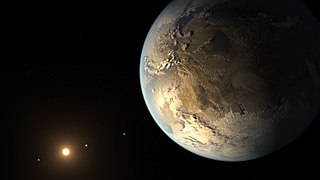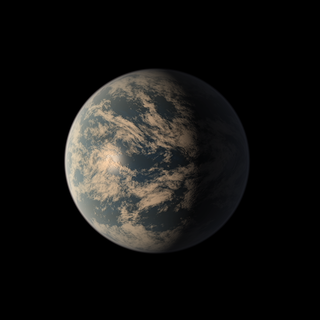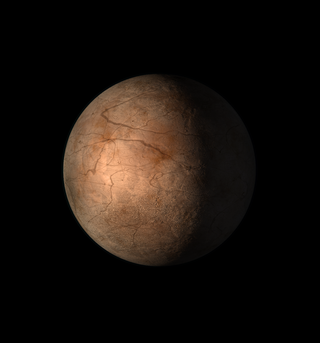Related Research Articles

A Super-Earth or super-terran is a type of exoplanet with a mass higher than Earth's, but substantially below those of the Solar System's ice giants, Uranus and Neptune, which are 14.5 and 17 times Earth's, respectively. The term "super-Earth" refers only to the mass of the planet, and so does not imply anything about the surface conditions or habitability. The alternative term "gas dwarfs" may be more accurate for those at the higher end of the mass scale, although "mini-Neptunes" is a more common term.

Transit-timing variation is a method for detecting exoplanets by observing variations in the timing of a transit. This provides an extremely sensitive method capable of detecting additional planets in the system with masses potentially as small as that of Earth. In tightly packed planetary systems, the gravitational pull of the planets among themselves causes one planet to accelerate and another planet to decelerate along its orbit. The acceleration causes the orbital period of each planet to change. Detecting this effect by measuring the change is known as transit-timing variations. "Timing variation" asks whether the transit occurs with strict periodicity or if there's a variation.

An exoplanet is a planet located outside the Solar System. The first evidence of an exoplanet was noted as early as 1917, but was not recognized as such until 2016; no planet discovery has yet come from that evidence. What turned out to be the first detection of an exoplanet was published among a list of possible candidates in 1988, though not confirmed until 2003. The first confirmed detection came in 1992, with the discovery of terrestrial-mass planets orbiting the pulsar PSR B1257+12. The first confirmation of an exoplanet orbiting a main-sequence star was made in 1995, when a giant planet was found in a four-day orbit around the nearby star 51 Pegasi. Some exoplanets have been imaged directly by telescopes, but the vast majority have been detected through indirect methods, such as the transit method and the radial-velocity method. As of 24 July 2024, there are 7,026 confirmed exoplanets in 4,949 planetary systems, with 1007 systems having more than one planet. This is a list of the most notable discoveries.
Kepler-47 is a binary star system in the constellation Cygnus located about 3,420 light-years away from Earth. The stars have three exoplanets, all of which orbit both stars at the same time, making this a circumbinary system. The first two planets announced are designated Kepler-47b, and Kepler-47c, and the third, later discovery is Kepler-47d. Kepler-47 is the first circumbinary multi-planet system discovered by the Kepler mission. The outermost of the planets is a gas giant orbiting within the habitable zone of the stars. Because most stars are binary, the discovery that multi-planet systems can form in such a system has impacted previous theories of planetary formation.
Kepler-80, also known as KOI-500, is a red dwarf star of the spectral type M0V. This stellar classification places Kepler-80 among the very common, cool, class M stars that are still within their main evolutionary stage, known as the main sequence. Kepler-80, like other red dwarf stars, is smaller than the Sun, and it has both radius, mass, temperatures, and luminosity lower than that of our own star. Kepler-80 is found approximately 1,223 light years from the Solar System, in the stellar constellation Cygnus, also known as the Swan.

Kepler-37, also known as UGA-1785, is a G-type main-sequence star located in the constellation Lyra 209 light-years from Earth. It is host to exoplanets Kepler-37b, Kepler-37c, Kepler-37d and possibly Kepler-37e, all of which orbit very close to it. Kepler-37 has a mass about 80.3 percent of the Sun's and a radius about 77 percent as large. It has a temperature similar to that of the Sun, but a bit cooler at 5,357 K. It has about half the metallicity of the Sun. With an age of roughly 6 billion years, it is slightly older than the Sun, but is still a main-sequence star. Until January 2015, Kepler-37 was the smallest star to be measured via asteroseismology.

Kepler-62 is a K-type main sequence star cooler and smaller than the Sun, located roughly 980 light-years from Earth in the constellation Lyra. It resides within the field of vision of the Kepler spacecraft, the satellite that NASA's Kepler Mission used to detect planets that may be transiting their stars. On April 18, 2013, it was announced that the star has five planets, two of which, Kepler-62e and Kepler-62f are within the star's habitable zone. The outermost, Kepler-62f, is likely a rocky planet.

Kepler-62f is a super-Earth exoplanet orbiting within the habitable zone of the star Kepler-62, the outermost of five such planets discovered around the star by NASA's Kepler space telescope. It is located about 982 light-years from Earth in the constellation of Lyra.

Kepler-186f is an Earth-sized exoplanet orbiting within the habitable zone of the red dwarf star Kepler-186, the outermost of five such planets discovered around the star by NASA's Kepler space telescope. It is located about 580 light-years from Earth in the constellation of Cygnus.

SPECULOOS (Search for habitable Planets EClipsing ULtra-cOOl Stars) is a project consisting of SPECULOOS Southern Observatory (SSO) at the Paranal Observatory in Chile and SPECULOOS Northern Observatory (SNO) at the Teide Observatory in Tenerife.

TRAPPIST-1d is a small exoplanet, which orbits on the inner edge of the habitable zone of the ultracool dwarf star TRAPPIST-1, located 40.7 light-years away from Earth in the constellation of Aquarius. The exoplanet was found by using the transit method. The first signs of the planet were announced in 2016, but it was not until the following years that more information concerning the probable nature of the planet was obtained. TRAPPIST-1d is the second-least massive planet of the system and is likely to have a compact hydrogen-poor atmosphere similar to Venus, Earth, or Mars. It receives just 4.3% more sunlight than Earth, placing it on the inner edge of the habitable zone. It has about <5% of its mass as a volatile layer, which could consist of atmosphere, oceans, and/or ice layers. A 2018 study by the University of Washington concluded that TRAPPIST-1d might be a Venus-like exoplanet with an uninhabitable atmosphere. The planet is an eyeball planet candidate.

TRAPPIST-1b is a mainly rocky exoplanet orbiting around the ultra-cool dwarf star TRAPPIST-1, located 40.7 light-years away from Earth in the constellation of Aquarius. The planet was detected using the transit method, where a planet dims the host star's light as it passes in front of it. It was first announced on May 2, 2016, and later studies were able to refine its physical parameters.

TRAPPIST-1c, also designated as 2MASS J23062928-0502285 c, is a mainly rocky exoplanet orbiting around the ultracool dwarf star TRAPPIST-1, located 40.7 light-years (12.5 parsecs) away from Earth in the constellation Aquarius. It is the third most massive and third largest planet of the system, with about 131% the mass and 110% the radius of Earth. Its density indicates a primarily rocky composition, and observations by the James Webb Space Telescope announced in 2023 suggests against a thick CO2 atmosphere, however this does not exclude a thick abiotic oxygen-dominated atmosphere as is hypothesized to be common around red dwarf stars.

TRAPPIST-1f, also designated as 2MASS J23062928-0502285 f, is an exoplanet, likely rocky, orbiting within the habitable zone around the ultracool dwarf star TRAPPIST-1, located 40.7 light-years away from Earth in the constellation of Aquarius. The exoplanet was found by using the transit method, in which the dimming effect that a planet causes as it crosses in front of its star is measured.

TRAPPIST-1g, also designated as 2MASS J23062928-0502285 g and K2-112 g, is an exoplanet orbiting around the ultra-cool dwarf star TRAPPIST-1, located 40.7 light-years away from Earth in the constellation Aquarius. It was one of four new exoplanets to be discovered orbiting the star in 2017 using observations from the Spitzer Space Telescope. The exoplanet is within the optimistic habitable zone of its host star. It was found by using the transit method, in which the dimming effect that a planet causes as it crosses in front of its star is measured.

TRAPPIST-1e, also designated as 2MASS J23062928-0502285 e, is a rocky, close-to-Earth-sized exoplanet orbiting within the habitable zone around the ultracool dwarf star TRAPPIST-1, located 40.7 light-years away from Earth in the constellation of Aquarius. Astronomers used the transit method to find the exoplanet, a method that measures the dimming of a star when a planet crosses in front of it.

TRAPPIST-1h, also designated as 2MASS J23062928-0502285 h, is an exoplanet orbiting around the ultra-cool dwarf star TRAPPIST-1, located 40.7 light-years away from Earth in the constellation Aquarius. It was one of four new exoplanets to be discovered orbiting the star in 2017 using observations from the Spitzer Space Telescope. In the following years, more studies were able to refine its physical parameters.
TOI-700 is a red dwarf 101.4 light-years away from Earth located in the Dorado constellation that hosts TOI-700 d, the first Earth-sized exoplanet in the habitable zone discovered by the Transiting Exoplanet Survey Satellite (TESS).

TOI-700 d is a near-Earth-sized exoplanet, likely rocky, orbiting within the habitable zone of the red dwarf TOI-700, the outermost planet within the system. It is located roughly 101.4 light-years (31.1 pc) away from Earth in the constellation of Dorado. The exoplanet is the first Earth-sized exoplanet in the habitable zone discovered by the Transiting Exoplanet Survey Satellite (TESS).
References
- ↑ "John Simon Guggenheim Foundation | Eric Agol" . Retrieved 2020-08-24.
- ↑ "| NASA Astrobiology Institute". astrobiology.nasa.gov. Retrieved 2020-08-24.
- ↑ "Eric Agol, UW Astronomy". faculty.washington.edu. Retrieved 2020-08-24.
- 1 2 "Agol, Eric – Department of Astronomy" . Retrieved 2020-08-24.
- ↑ Falcke, Heino; Melia, Fulvio; Agol, Eric (1 January 2000). "Viewing the Shadow of the Black Hole at the Galactic Center". The Astrophysical Journal. 528 (1): L13–L16. arXiv: astro-ph/9912263 . Bibcode:2000ApJ...528L..13F. doi:10.1086/312423. PMID 10587484. S2CID 119433133.
- ↑ Overbye, Dennis (10 April 2019). "Darkness Visible, Finally: Astronomers Capture First Ever Image of a Black Hole". The New York Times.
- ↑ "'Upside-down planet' reveals new method for studying binary star systems". UW News.
- ↑ Agol, E.; Steffen, J.; Sari, R.; Clarkson, W. (11 May 2005). "On detecting terrestrial planets with timing of giant planet transits". Monthly Notices of the Royal Astronomical Society. 359 (2): 567–579. arXiv: 2005.08922 . Bibcode:2005MNRAS.359..567A. doi: 10.1111/j.1365-2966.2005.08922.x . S2CID 16196696.
- ↑ Cowan, N. B.; Agol, E.; Charbonneau, D. (1 August 2007). "Hot nights on extrasolar planets: mid-infrared phase variations of hot Jupiters". Monthly Notices of the Royal Astronomical Society. 379 (2): 641–646. arXiv: 0705.1189 . Bibcode:2007MNRAS.379..641C. doi: 10.1111/j.1365-2966.2007.11897.x .
- ↑ Knutson, Heather A.; Charbonneau, David; Allen, Lori E.; Fortney, Jonathan J.; Agol, Eric; Cowan, Nicolas B.; Showman, Adam P.; Cooper, Curtis S.; Megeath, S. Thomas (May 2007). "A map of the day–night contrast of the extrasolar planet HD 189733b". Nature. 447 (7141): 183–186. arXiv: 0705.0993 . Bibcode:2007Natur.447..183K. doi: 10.1038/nature05782 . PMID 17495920.
- ↑ Agol, Eric (April 2011). "Transit Surveys for Earths in the Habitable Zones of White Dwarfs". The Astrophysical Journal Letters. 731 (2): L31. arXiv: 1103.2791 . Bibcode:2011ApJ...731L..31A. doi:10.1088/2041-8205/731/2/L31. S2CID 118739494.
- ↑ Ashley Strickland. "Giant planet found orbiting a dead white dwarf star". CNN.
- ↑ "UW astronomer helps discover planet 1,200 light years from Earth". king5.com.
- ↑ "Edmonds astronomer plays key role in discovery of two moonless planets". My Edmonds News. 7 July 2012.
- ↑ "Astronomers discover five-planet system with most Earth-like exoplanet yet". UW News. Retrieved 2020-08-31.
- ↑ Will Mari. "Life on Kepler-62f? How a UW astronomer found a tantalizing new world". geekwire. Retrieved 2020-08-31.
- ↑ "The UW connection to an amazing astronomical discovery". Q13 FOX. 23 February 2017.
- ↑ "UW astronomer Eric Agol assists in new seven-planet NASA discovery using 'distracted driving' technique". UW News. Retrieved 2020-08-24.
- ↑ "UW astrophysicist played role in discovery of new planets". king5.com. Retrieved 2020-08-31.
- ↑ Foreman-Mackey, Daniel; Agol, Eric; Ambikasaran, Sivaram; Angus, Ruth (9 November 2017). "Fast and Scalable Gaussian Process Modeling with Applications to Astronomical Time Series". The Astronomical Journal. 154 (6): 220. arXiv: 1703.09710 . Bibcode:2017AJ....154..220F. doi: 10.3847/1538-3881/aa9332 . S2CID 88521913.
- ↑ "UW astrophysicist played role in discovery of new planets". king5.com. 24 February 2017.
- ↑ "TRAPPIST-1's Seven Earth-Sized Planets Are Likely All Made Of The Same Stuff". IFLScience.
- ↑ "The 7 Rocky TRAPPIST-1 Planets May Be Made of Similar Stuff". Jet Propulsion Laboratory .
- ↑ "Interview with Ian Agol" (PDF). Notices of the American Mathematical Society . 63 (1): 24. January 2016.
- ↑ "Alan Agol". Marin Independent Journal . October 5, 2005.